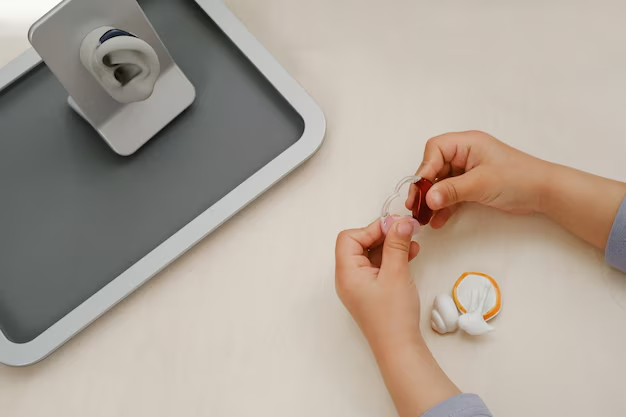How to Effectively Clean Your In-the-Ear (ITE) Hearing Aid Receiver
If you rely on an In-the-Ear (ITE) hearing aid, maintaining its performance is crucial. A key component that often needs attention is the receiver. Proper cleaning ensures your hearing aid functions optimally. Let's walk through practical steps and tips for keeping your hearing aid in top shape.
Understanding the Importance of Cleaning Your Hearing Aid Receiver
Why Cleaning Matters
Hearing aids, especially the ITE models, sit within the ear canal, exposing them to earwax and moisture. Over time, these elements can accumulate and impact the device's performance.
Benefits of Regular Cleaning:
- Improves Sound Quality: Removing debris ensures a clearer reception of sounds.
- Extends Device Lifespan: Keeps the inner components in good condition.
- Reduces Repairs: Prevents blockages that might necessitate professional service.
Gathering the Right Tools
Before you begin cleaning, ensure you have the necessary tools on hand:
- Wax Pick: For removing small deposits of earwax.
- Soft Brush: To sweep away loose debris.
- Microfiber Cloth: Ideal for wiping surfaces without scratching.
- Cleaning Solution: Specially formulated for hearing aids, not household cleaners.
Step-by-Step Cleaning Guide
1. Prepare Your Workspace
Find a clean, well-lit area to perform the cleaning. Lay down a soft cloth to prevent any accidental drops from damaging the device.
2. Turn Off the Hearing Aid
Always switch off your hearing aid before cleaning to prevent any damage.
3. Remove the Battery
For safety and efficiency, take out the battery. This step also allows you to inspect the battery compartment for corrosion or debris.
4. Use a Wax Guard
Many ITE hearing aids come with a wax guard or filter. Ensure it is intact and change it regularly as part of your maintenance routine.
5. Gently Clean the Receiver
With your tools ready, follow these steps:
Use the Wax Pick: Carefully remove any visible wax from the receiver. Be gentle to avoid damaging the delicate parts.
Brush Away Debris: Use the soft brush to clear away any loosened particles. Brush in different directions to thoroughly clean the area.
Wipe with a Cloth: Moisten a microfiber cloth with your cleaning solution. Wipe the outer surfaces carefully, taking care not to let liquid seep into the device.
6. Inspect for Damage
As you clean, check for any signs of wear or damage. If you notice anything unusual, consider consulting a hearing care professional.
Addressing Common Cleaning Challenges
Earwax Management
Tip: Regular ear hygiene can reduce buildup. Earwax softeners might help, but consult with a healthcare provider for safe options.
Moisture Concerns
For those in humid climates or active lifestyles, moisture can be a challenge:
- Use a Dehumidifier: Purchase a hearing aid dehumidifier for overnight storage.
- Avoid Exposure: Keep your hearing aid away from water or intense humidity.
Troubleshooting Cleaning Problems
Persistent Blockage
If your hearing aid seems blocked despite regular cleaning, it might be time for a professional cleaning. Audiologists often offer deep-cleaning services.
Declining Performance
Occasionally, cleaning might not resolve performance issues, which could indicate a need for repair or replacement parts.
Best Practices for Ongoing Maintenance
Develop a Routine
Incorporate cleaning into your daily or weekly routine. Consistency helps maintain sound quality.
Dry Overnight
Make it a habit to store your hearing aid in a dehumidifying container at night.
Regular Professional Checks
Even with diligent maintenance, annual check-ups with a hearing aid specialist can preempt more serious issues.
Visual Summary: Cleaning Tips for ITE Hearing Aids
🧼 Key Cleaning Steps:
- Use a wax pick to gently remove buildup.
- Brush the receiver with a soft tool.
- Use a microfiber cloth and specialized cleaning solution.
🔄 Routine Maintenance:
- Dry the hearing aid overnight with a dehumidifier.
- Replace the wax guard regularly.
- Schedule yearly professional inspections.
🚫 Avoid Common Pitfalls:
- Do not use household cleaners.
- Never submerge in water.
- Avoid exposing to extreme heat or moisture.
Final Insights
Caring for your ITE hearing aid's receiver is not just about ensuring better sound quality—it's about sustaining the device's longevity and reliability. By following these cleaning and maintenance guidelines, you not only improve your daily auditory experience but also potentially save on costly repairs. Take charge of your hearing health by making these steps a regular habit.
Engaging actively in the upkeep of your hearing aid not only enhances its performance but also empowers you to make the most of this essential device daily.

Related Topics
- a Plus Hearing Aid Centers
- a Real Pain Showtimes Near Centerville
- Are Airpods Bad For Your Ears
- Are Apple Second Generation Airpods Hearing Aids
- Are Audien Hearing Aids Just Amplifiers
- Are Costco Hearing Aids As Good As Others
- Are Costco Hearing Aids Good
- Are Hearing Aid Domes Interchangeable
- Are Hearing Aid Subscriptions Worth It
- Are Hearing Aid Tax Deductible